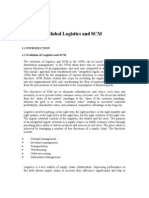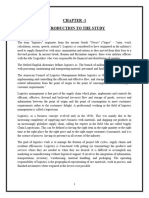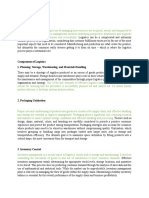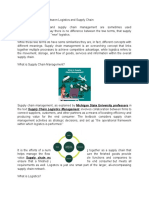0 ratings0% found this document useful (0 votes)
23 viewsLogistic Management (Module 4) - MIpranum, Rjay
This document contains a student's assessment responses from a logistics management module.
The student learned that logistics is an essential part of supply chain management, involving planning and managing the movement of goods, services, and information from origin to consumption. Logistics aligns transportation, shipping, inventory, and other operations to deliver products smoothly and cost-effectively. As global trade increased, logistics became critical for managing resources and meeting consumer demand. Companies realized they could lower costs through efficient logistics systems.
The student finds third-party logistics and logistics outsourcing difficult to understand fully in the context of logistics management.
Uploaded by
Aileen Mifranum IICopyright
© © All Rights Reserved
Available Formats
Download as DOCX, PDF, TXT or read online on Scribd
0 ratings0% found this document useful (0 votes)
23 viewsLogistic Management (Module 4) - MIpranum, Rjay
This document contains a student's assessment responses from a logistics management module.
The student learned that logistics is an essential part of supply chain management, involving planning and managing the movement of goods, services, and information from origin to consumption. Logistics aligns transportation, shipping, inventory, and other operations to deliver products smoothly and cost-effectively. As global trade increased, logistics became critical for managing resources and meeting consumer demand. Companies realized they could lower costs through efficient logistics systems.
The student finds third-party logistics and logistics outsourcing difficult to understand fully in the context of logistics management.
Uploaded by
Aileen Mifranum IICopyright
© © All Rights Reserved
Available Formats
Download as DOCX, PDF, TXT or read online on Scribd
You are on page 1/ 2
MIPRANUM, RJAY L.
LOGISTIC MANAGEMENT – A
MODULE 4
ASSESSMENT
1. What’s the most important thing you learned today? Why do you think so?
Logistics is an essential component of supply chain management. It involves the
planning, carrying out and management of goods, services, and information from the
point of origin to the point of consumption. Logistics aligns the complex pattern of traffic
and transportation, shipping and receiving, import and export operations, warehousing,
inventory management, purchasing, production planning, and customer service.
Companies see logistics as a critical blueprint of the supply chain. It is used to manage,
coordinate and monitor resources needed to move products in a smooth, timely, cost-
effective and reliable manner. As the global economy moved into the 21st Century,
logistics became a critical part of supply chain management and consumer demand. In
less than two decades, logistics management has influenced product movement to
meet or exceed consumer demand. Companies saw they could lower costs and
increase productivity by managing logistics on a system theory and managing the
company as a whole to boost performance.
By creating partnerships with suppliers, shipping services and warehouse, and
connecting these services through automated systems, the logistics of getting products
to the consumer are improved with reduced overhead costs and faster delivery.
Understanding how the logistics system theory works require strategic planning when
calculating what will be needed while focusing on obtaining materials and managing
how quickly products are produced to help ensure swift delivery to the consumer.
Simplifying communication and services between multiple departments help create a
workflow blueprint that reduces costs by increasing visibility and improving the overall
understanding of company needs. Cost savings is created by reducing warehousing
costs and purchasing based on supply forecasts, better inventory management, reliable
shipping and timely delivery to the end-user.
REFLECTION
1. What topic do you find difficult to understand?
I find difficult in Third-party logistics, also called logistics outsourcing or
contract logistics, continues to be one of the most misunderstood terms in logistics
and SCM. How it really works in Logistic management.
You might also like
- "Title of The Project": Veer Narmad South Gujarat University (Vnsgu)No ratings yet"Title of The Project": Veer Narmad South Gujarat University (Vnsgu)85 pages
- Logistics and Supply Chain Management - 2014100% (4)Logistics and Supply Chain Management - 2014127 pages
- MZU-SEM I-MBA-Fundamentals of Logistics and Supply Management-Unit 1No ratings yetMZU-SEM I-MBA-Fundamentals of Logistics and Supply Management-Unit 140 pages
- Logistic and Supply Chain Management Report OnNo ratings yetLogistic and Supply Chain Management Report On16 pages
- Chain? "Logistics and Supply Chain Both Are Inseparable and Not Contradictory Each Other" - Explain This StatementNo ratings yetChain? "Logistics and Supply Chain Both Are Inseparable and Not Contradictory Each Other" - Explain This Statement6 pages
- Introduction To Retail Management Module 1100% (1)Introduction To Retail Management Module 152 pages
- International Marketing and Logistics Management: LogisticsNo ratings yetInternational Marketing and Logistics Management: Logistics27 pages
- International Supply Chain and Logistics ManagementNo ratings yetInternational Supply Chain and Logistics Management98 pages
- Actividad de Aprendizaje 19 Evidencia 7 Ingles Presentación 2022No ratings yetActividad de Aprendizaje 19 Evidencia 7 Ingles Presentación 20228 pages
- Assignment:-Mba 3 SEM Devesh Kumar 2019533534 Submitted To - Pro. Ambika KhuranaNo ratings yetAssignment:-Mba 3 SEM Devesh Kumar 2019533534 Submitted To - Pro. Ambika Khurana12 pages
- Week 11 Module-Logistics and Supply Chain ManagementNo ratings yetWeek 11 Module-Logistics and Supply Chain Management9 pages
- AA2. Module 2 Transport Logistics Management44No ratings yetAA2. Module 2 Transport Logistics Management4413 pages
- Logistics Management: Principles, Strategies, Technologies, Terms, and Q&AFrom EverandLogistics Management: Principles, Strategies, Technologies, Terms, and Q&ANo ratings yet
- Fundamentals of Logistics and Warehousing: The Supply Chain Journey, #4From EverandFundamentals of Logistics and Warehousing: The Supply Chain Journey, #4No ratings yet
- Strategic Procurement From Cost-Cutting To Competitive AdvantageFrom EverandStrategic Procurement From Cost-Cutting To Competitive AdvantageNo ratings yet
- Procedure and Documentation in Supply Chain Management: Business strategy books, #1From EverandProcedure and Documentation in Supply Chain Management: Business strategy books, #1No ratings yet
- Week 3 Tax 2 - Assignment - MIPRANUM, RJAYNo ratings yetWeek 3 Tax 2 - Assignment - MIPRANUM, RJAY2 pages
- Logistic Management (Module 2) - MIpranum, RjayNo ratings yetLogistic Management (Module 2) - MIpranum, Rjay2 pages
- Logistic Management (Module 1) - MIpranum, RjayNo ratings yetLogistic Management (Module 1) - MIpranum, Rjay2 pages
- Deliverable Form D - 5-Year Action Plans Adolescent PregnancyNo ratings yetDeliverable Form D - 5-Year Action Plans Adolescent Pregnancy10 pages









































































